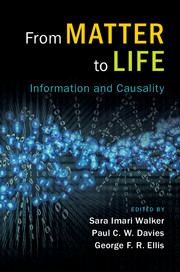Book contents
- Frontmatter
- Contents
- About the authors
- 1 Introduction
- Part I Physics and Life
- Part II Bio from Bit
- 4 (How) Did Information Emerge?
- 5 On the Emerging Codes for Chemical Evolution
- 6 Digital and Analogue Information in Organisms
- 7 From Entropy to Information: Biased Typewriters and the Origin of Life
- Part III Life's Hidden Information
- Part IV Complexity and Causality
- Part V From Matter to Mind
- Index
6 - Digital and Analogue Information in Organisms
from Part II - Bio from Bit
Published online by Cambridge University Press: 02 March 2017
- Frontmatter
- Contents
- About the authors
- 1 Introduction
- Part I Physics and Life
- Part II Bio from Bit
- 4 (How) Did Information Emerge?
- 5 On the Emerging Codes for Chemical Evolution
- 6 Digital and Analogue Information in Organisms
- 7 From Entropy to Information: Biased Typewriters and the Origin of Life
- Part III Life's Hidden Information
- Part IV Complexity and Causality
- Part V From Matter to Mind
- Index
Summary
Organisms reproduce themselves, which means that their structures and processes must be copied to pass on to later generations. The question addressed in this chapter is whether they do this by encoding everything in digital format or whether analogue information is also important. The complete genome sequence of an organism is often compared to the digital information in a computer program or data file. Strong versions of biological reductionism also assume that this information is sufficient to define the organism and its development. This idea, popularised today in the idea of a genetics program, has its origins in the mechanistic philosophy of René Descartes. In his treatise on the formation of the fetus in 1664, he wrote:
If one had a proper knowledge of all the parts of the semen of some species of animal in particular, for example of man, one might be able to deduce the whole form and configuration of each of its members from this alone, by means of entirely mathematical and certain arguments, the complete figure and the conformation of its members. (De la formation du fetus, 1664, para LXVI, p. 146)
This statement can be seen to foreshadow the Central Dogma of molecular biology (Crick, 1970), which in turn can be seen to echo the idea of the Weismann Barrier (Weismann, 1893): that the genetic material is isolated from both the rest of the organism and its environment and that it is sufficient in itself to specify the development of an organism.
THE QUESTION
The question addressed in this chapter is: Are organisms encoded as purely digital molecular descriptions in their gene sequences? By analysing the genome alone, could we then solve the forward problem of computing the behaviour of the system from this information? I argue that the first is incorrect and that the second is impossible. We therefore need to replace the gene-centric digital view of the relation between genotype and phenotype with an integrative view that also recognises the importance of analogue information in organisms and its contribution to inheritance across generations. Nature and nurture must interact. Either on its own can do nothing.
- Type
- Chapter
- Information
- From Matter to LifeInformation and Causality, pp. 114 - 129Publisher: Cambridge University PressPrint publication year: 2017
- 4
- Cited by



